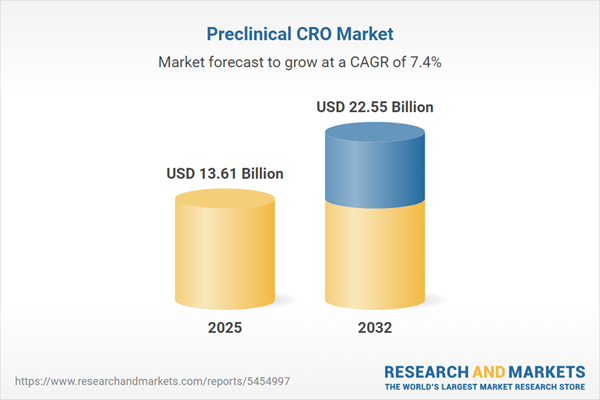Speak directly to the analyst to clarify any post sales queries you may have.
The Preclinical CRO Market is rapidly evolving, shaped by advancement in technology and the increasing complexity in drug discovery. Senior executives seeking robust market intelligence will find strategic direction and in-depth analysis to guide pivotal business decisions in this comprehensive report.
Market Snapshot: Preclinical CRO Market Size and Growth
The Preclinical CRO Market grew from USD 12.74 billion in 2024 to USD 13.61 billion in 2025, and is expected to expand at a CAGR of 7.39%, reaching USD 22.55 billion by 2032. This sustained momentum underscores the strong demand for contract research services as pharmaceutical and biotechnology sectors increase their reliance on specialized outsourcing to accelerate drug pipeline efficiency and manage operational complexities.
Scope & Segmentation of the Preclinical CRO Market
- Service Type: Bioanalytical Services, Clinical Pathology Services, Pharmacokinetics & Pharmacodynamics Testing, Safety Pharmacology, Toxicology Testing
- Stage of Development: Lead Generation, Lead Optimization, Preclinical Development
- Model Type: Patient Derived Organoid (PDO) Model, Patient Derived Xenograft Model
- Application: Cardiology (Cardiac Hypertrophy Treatments, Cardiovascular Disease Research, Heart Failure Studies), Neurology (Alzheimer's Research, Cognitive Disorder Treatments, Parkinson's Disease Studies), Oncology (Chemotherapy Research, Immunotherapy Studies)
- End User: Academic & Research Institutes, Biotechnology Companies, Pharmaceutical Companies
- Regions Analyzed: Americas (United States, Canada, Mexico, Brazil, Argentina, Chile, Colombia, Peru), Europe, Middle East & Africa (United Kingdom, Germany, France, Russia, Italy, Spain, Netherlands, Sweden, Poland, Switzerland, United Arab Emirates, Saudi Arabia, Qatar, Turkey, Israel, South Africa, Nigeria, Egypt, Kenya), Asia-Pacific (China, India, Japan, Australia, South Korea, Indonesia, Thailand, Malaysia, Singapore, Taiwan)
- Leading Companies Profiled: 10x Genomics, Inc.; AmplifyBio LLC; Biotrofix, Inc.; Eurofins Scientific SE; F. Hoffmann-La Roche Ltd.; Genesis Biotechnology Group, LLC; Inotiv, Inc.; IQVIA Inc.; JSR Corporation; PPD by Thermo Fisher Scientific Inc.; Sanofi S.A.
Key Takeaways for Decision-Makers
- Integration of digital technologies and automation is improving the efficiency and precision of preclinical workflows, resulting in faster data output and more accurate insights.
- Growing demand for personalized medicine has led to the increased adoption of patient-derived models, reshaping research focus and service offerings for contract research organizations.
- Collaboration models—such as strategic alliances and joint ventures—are more common, providing opportunities for resource-sharing and co-development between pharmaceutical companies and specialized service providers.
- The need for bundled services is rising, with end users increasingly seeking providers that combine pharmacokinetics, toxicology, and advanced clinical pathology within unified solutions.
- Academic and research institutes drive early-stage innovation, while biotechnology leaders and pharmaceutical firms are streamlining preclinical workflows through large-scale, integrated outsourcing relationships.
- Regional dynamics reveal expanding opportunities, especially in Asia-Pacific, where public funding and technology adoption support the growth of local bioanalytical and toxicology testing services.
Tariff Impact on Operations and Global Collaboration
The introduction of higher U.S. tariffs on laboratory equipment and reagents has increased operational complexity for global preclinical research collaborations. Service providers and sponsors are adopting regional sourcing, renegotiating contract terms with pricing stability clauses, and exploring supply chain diversification to minimize the impact of policy change on project continuity. These shifts highlight the increasing importance of geographic agility and long-term cost control strategies.
Methodology & Data Sources
Research findings are built on an integrated approach that includes extensive literature review, in-depth executive interviews, and statistical analysis. Rigorous data triangulation and peer-review processes ensure reliable, actionable insights underpinning every strategic conclusion.
Why This Report Matters for Senior Leaders
- Guides investment decisions by identifying growth segments, disruptive technologies, and regional entry points in the preclinical CRO market.
- Enables proactive risk mitigation and opportunity capture in response to regulatory, technological, and geopolitical shifts impacting the industry.
- Supports strategic partnership, procurement, and resource allocation decisions with objective benchmarking and competitive intelligence.
Conclusion
This report empowers senior leadership with the clarity to navigate change, invest in emerging areas, and drive success in a complex preclinical CRO ecosystem. By aligning with market dynamics and innovative technologies, organizations can sustain growth and strengthen competitive positioning across regions and service portfolios.
Additional Product Information:
- Purchase of this report includes 1 year online access with quarterly updates.
- This report can be updated on request. Please contact our Customer Experience team using the Ask a Question widget on our website.
Table of Contents
3. Executive Summary
4. Market Overview
7. Cumulative Impact of Artificial Intelligence 2025
Companies Mentioned
The companies profiled in this Preclinical CRO market report include:- 10x Genomics, Inc.
- AmplifyBio LLC
- Biotrofix, Inc.
- Eurofins Scientific SE
- F. Hoffmann-La Roche Ltd.
- Genesis Biotechnology Group, LLC
- Inotiv, Inc.
- IQVIA Inc.
- JSR Corporation
- PPD by Thermo Fisher Scientific Inc.
- Sanofi S.A.
Table Information
| Report Attribute | Details |
|---|---|
| No. of Pages | 190 |
| Published | November 2025 |
| Forecast Period | 2025 - 2032 |
| Estimated Market Value ( USD | $ 13.61 Billion |
| Forecasted Market Value ( USD | $ 22.55 Billion |
| Compound Annual Growth Rate | 7.3% |
| Regions Covered | Global |
| No. of Companies Mentioned | 12 |









